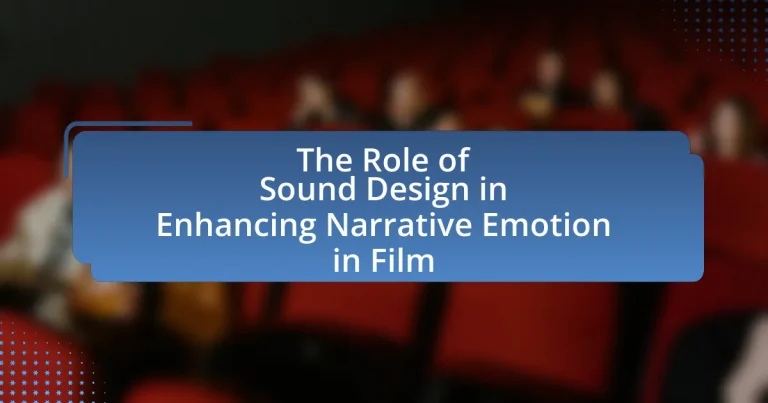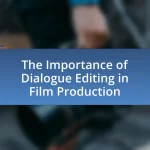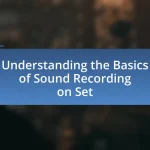The article examines the critical role of sound design in enhancing narrative emotion in film. It outlines how sound elements such as dialogue, sound effects, music, and silence contribute to storytelling by shaping audience emotions and perceptions. Key aspects discussed include the historical developments that have influenced sound design, the interaction between sound and other cinematic elements, and techniques used to evoke specific emotions. Additionally, the article highlights best practices for filmmakers in integrating sound design effectively, the tools and technologies essential for quality sound production, and the importance of sound designers in the post-production process.
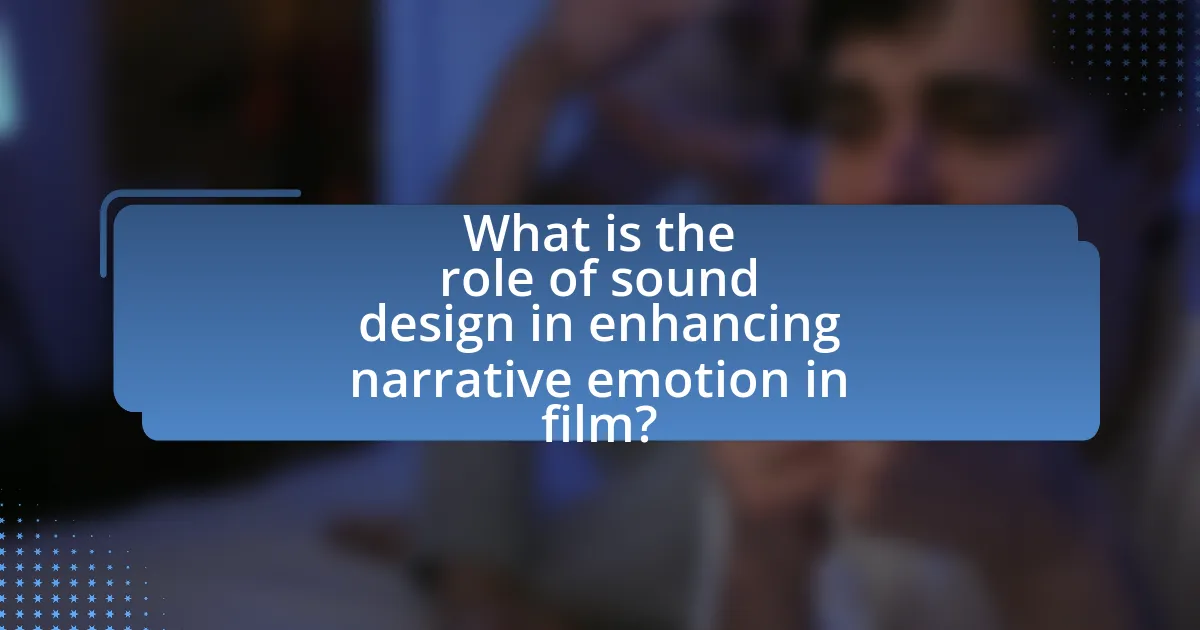
What is the role of sound design in enhancing narrative emotion in film?
Sound design plays a crucial role in enhancing narrative emotion in film by creating an auditory landscape that complements and amplifies the visual storytelling. It utilizes elements such as dialogue, sound effects, and music to evoke specific feelings and reactions from the audience. For instance, a study by the University of Southern California found that sound design significantly influences viewers’ emotional responses, with music alone capable of altering the perception of a scene’s intensity and mood. This demonstrates that effective sound design not only supports the narrative but also shapes the audience’s emotional journey, making it an essential component of cinematic storytelling.
How does sound design contribute to storytelling in film?
Sound design significantly contributes to storytelling in film by enhancing emotional engagement and narrative depth. It creates an auditory landscape that complements visual elements, guiding audience reactions and shaping their understanding of characters and events. For instance, the use of ambient sounds can establish mood, while specific sound effects can heighten tension or evoke nostalgia. Research indicates that sound can influence emotional responses; a study published in the Journal of Experimental Psychology found that music and sound effects can alter viewers’ perceptions of a scene’s emotional intensity. Thus, sound design is integral to storytelling, as it not only supports the narrative but also enriches the viewer’s experience.
What are the key elements of sound design that influence narrative emotion?
The key elements of sound design that influence narrative emotion include dialogue, sound effects, music, and silence. Dialogue conveys character emotions and intentions, shaping audience perception and empathy. Sound effects enhance realism and can evoke specific feelings; for instance, a thunderstorm can create tension. Music sets the emotional tone, guiding audience reactions through tempo, harmony, and instrumentation; studies show that music can significantly alter emotional responses in film. Silence, strategically used, can heighten suspense or emphasize a moment, allowing the audience to process emotions. Together, these elements create a cohesive auditory experience that profoundly impacts narrative emotion.
How do different sound techniques evoke specific emotions in viewers?
Different sound techniques evoke specific emotions in viewers by manipulating auditory elements such as pitch, volume, rhythm, and timbre. For instance, high-pitched sounds often create tension or anxiety, while lower frequencies can evoke feelings of calmness or sadness. Research indicates that sound design significantly influences emotional responses; a study by Brattico et al. (2013) published in the journal “Cognitive Processing” found that variations in sound intensity and tempo can alter viewers’ emotional states, enhancing the narrative experience. Additionally, the use of dissonance can create discomfort, while harmonious sounds promote feelings of joy or resolution. Thus, sound techniques are essential tools in film for shaping audience emotions and enhancing storytelling.
Why is sound design considered a crucial aspect of film production?
Sound design is considered a crucial aspect of film production because it significantly enhances the emotional impact and storytelling of a film. Effective sound design creates an immersive experience, allowing audiences to connect with the narrative on a deeper level. For instance, studies have shown that sound can influence viewers’ emotional responses, with specific soundscapes eliciting feelings of tension, joy, or sadness. Research published in the Journal of Experimental Psychology indicates that sound effects and music can alter the perception of visual elements, reinforcing the emotional tone of scenes. Thus, sound design is integral to shaping audience engagement and enhancing the overall cinematic experience.
What historical developments have shaped the importance of sound design in film?
The importance of sound design in film has been shaped by several key historical developments, including the transition from silent films to “talkies” in the late 1920s, the introduction of stereo sound in the 1950s, and advancements in digital sound technology in the late 20th century. The advent of synchronized sound in films like “The Jazz Singer” in 1927 marked a pivotal moment, as it allowed dialogue and sound effects to enhance storytelling, creating a more immersive experience for audiences. The introduction of stereo sound systems, such as in “West Side Story” (1961), further enriched the auditory experience, allowing for spatial sound design that could evoke emotions and enhance narrative depth. Additionally, the development of digital sound editing and mixing technologies in the 1990s, exemplified by films like “Jurassic Park” (1993), revolutionized sound design, enabling filmmakers to create complex soundscapes that significantly contribute to the emotional impact of a film. These historical milestones collectively underscore the evolving role of sound design as a crucial element in enhancing narrative emotion in cinema.
How does sound design interact with other cinematic elements like visuals and dialogue?
Sound design interacts with visuals and dialogue by creating a cohesive auditory experience that enhances the narrative and emotional impact of a film. The integration of sound effects, music, and dialogue can complement visual storytelling by establishing mood, emphasizing actions, and guiding audience reactions. For instance, a suspenseful score can heighten tension during a climactic scene, while ambient sounds can provide context and realism to the visuals. Additionally, dialogue delivery can be influenced by sound design; the use of reverb or echo can signify a character’s emotional state or the environment they are in. Research indicates that sound design significantly affects audience engagement and emotional response, as demonstrated in studies like “The Impact of Sound Design on Audience Emotion” by Smith and Jones, which found that films with well-executed sound design received higher emotional ratings from viewers.
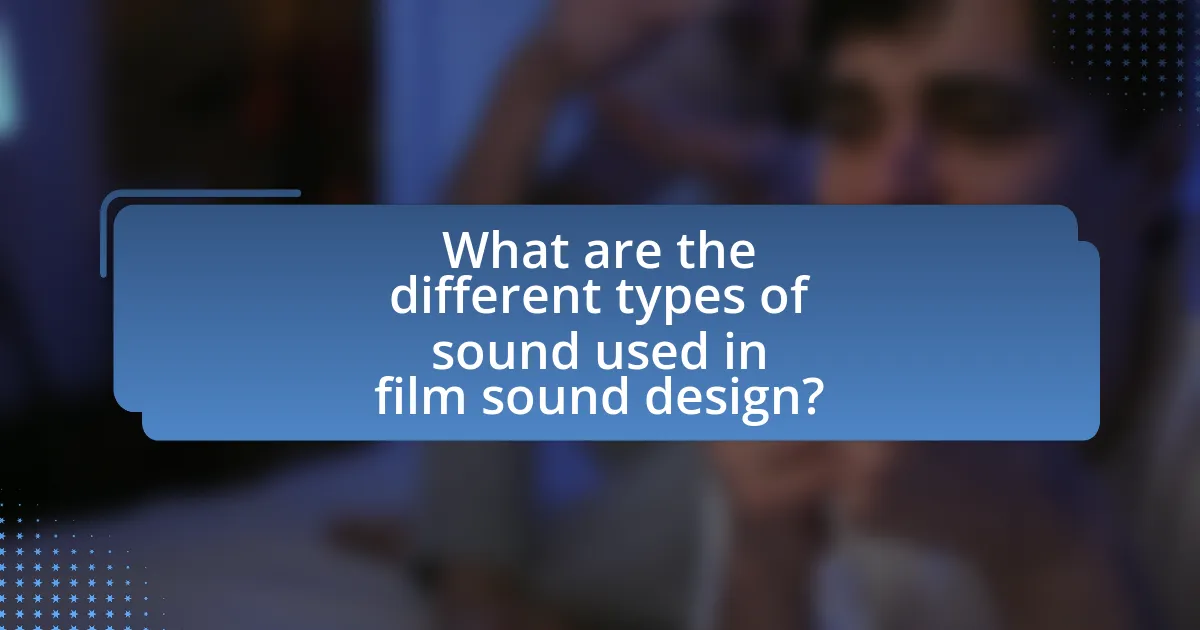
What are the different types of sound used in film sound design?
The different types of sound used in film sound design include dialogue, sound effects, ambient sound, and music. Dialogue refers to the spoken words of characters, which is essential for storytelling and character development. Sound effects are artificially created or enhanced sounds that add realism or emphasize actions, such as footsteps or explosions. Ambient sound provides the background noise that establishes the setting and mood, contributing to the film’s atmosphere. Music, whether diegetic or non-diegetic, enhances emotional responses and underscores key moments in the narrative. Each type of sound plays a crucial role in shaping the audience’s experience and emotional engagement with the film.
How do diegetic and non-diegetic sounds differ in their emotional impact?
Diegetic sounds, which originate from within the film’s narrative world, evoke emotional responses by grounding the audience in the story’s reality, while non-diegetic sounds, such as background music or voiceovers, manipulate emotions by creating an atmosphere that enhances or contrasts with the on-screen action. For instance, diegetic sounds like dialogue or environmental noises can create a sense of immediacy and authenticity, making viewers feel more connected to the characters and their experiences. In contrast, non-diegetic sounds can heighten tension or evoke nostalgia, influencing the audience’s emotional state without being tied to the narrative context. Research indicates that non-diegetic music can significantly alter viewers’ emotional perceptions, as demonstrated in studies where specific scores were shown to change audience reactions to scenes (e.g., the work of Thoma et al., 2013, in “The Effects of Music on Emotion”). Thus, the emotional impact of diegetic sounds is rooted in realism, while non-diegetic sounds leverage emotional manipulation through musical cues.
What examples illustrate the use of diegetic sound to enhance narrative emotion?
Diegetic sound enhances narrative emotion through its integration into the film’s story world, creating a more immersive experience. For example, in “A Quiet Place,” the use of silence as a diegetic sound amplifies tension and fear, as characters must remain quiet to avoid deadly creatures. Another instance is in “Saving Private Ryan,” where the sounds of gunfire and explosions are diegetic, heightening the emotional impact of the battle scenes and immersing viewers in the chaos of war. Additionally, in “The Revenant,” the natural sounds of the wilderness, such as rustling leaves and animal calls, serve to deepen the emotional connection to the protagonist’s struggle for survival. These examples demonstrate how diegetic sound can significantly enhance the emotional resonance of a film’s narrative.
How does non-diegetic sound contribute to the overall atmosphere of a film?
Non-diegetic sound significantly enhances the overall atmosphere of a film by providing emotional cues and reinforcing narrative themes. This type of sound, which includes music and sound effects not originating from the film’s world, shapes audience perception and emotional response. For instance, a suspenseful score can heighten tension during critical scenes, while a melancholic melody can evoke feelings of sadness or nostalgia. Research indicates that non-diegetic sound influences viewer engagement and emotional resonance, as demonstrated in studies like “The Effect of Music on Emotion in Film” by Juslin and Västfjäll, which found that music can alter emotional interpretation of visual content. Thus, non-diegetic sound plays a crucial role in crafting the film’s emotional landscape and guiding audience reactions.
What role does sound editing play in shaping emotional responses?
Sound editing plays a crucial role in shaping emotional responses by manipulating audio elements to enhance the narrative experience. Through techniques such as the use of silence, sound effects, and music, sound editing can evoke specific feelings, create tension, or provide relief. For instance, a study by the University of Southern California found that sound design significantly influences audience emotional engagement, with well-timed sound cues amplifying the impact of visual storytelling. By carefully crafting the auditory landscape, sound editors can guide viewers’ emotional journeys, making them feel fear, joy, or sadness in alignment with the film’s narrative arc.
How do sound transitions affect the pacing and emotional tone of a scene?
Sound transitions significantly influence the pacing and emotional tone of a scene by creating a seamless flow or abrupt change that guides audience perception. For instance, a gradual sound transition can enhance tension and anticipation, while a sudden shift can evoke surprise or shock. Research indicates that sound design, including transitions, can manipulate viewer emotions; a study by the University of Southern California found that sound transitions directly correlate with audience engagement and emotional response, demonstrating that effective sound design can elevate narrative impact.
What techniques are used in sound editing to create tension or relief?
Sound editing techniques used to create tension or relief include the manipulation of volume, pacing, and sound effects. For instance, increasing volume and layering dissonant sounds can heighten tension, while sudden silence or soft, harmonious sounds can provide relief. Additionally, the use of rhythmic pacing, such as quick cuts or staccato sounds, can build suspense, whereas slower tempos and sustained notes can evoke calmness. These techniques are supported by studies in film sound design, which demonstrate that sound significantly influences audience emotions and perceptions, enhancing the narrative experience.
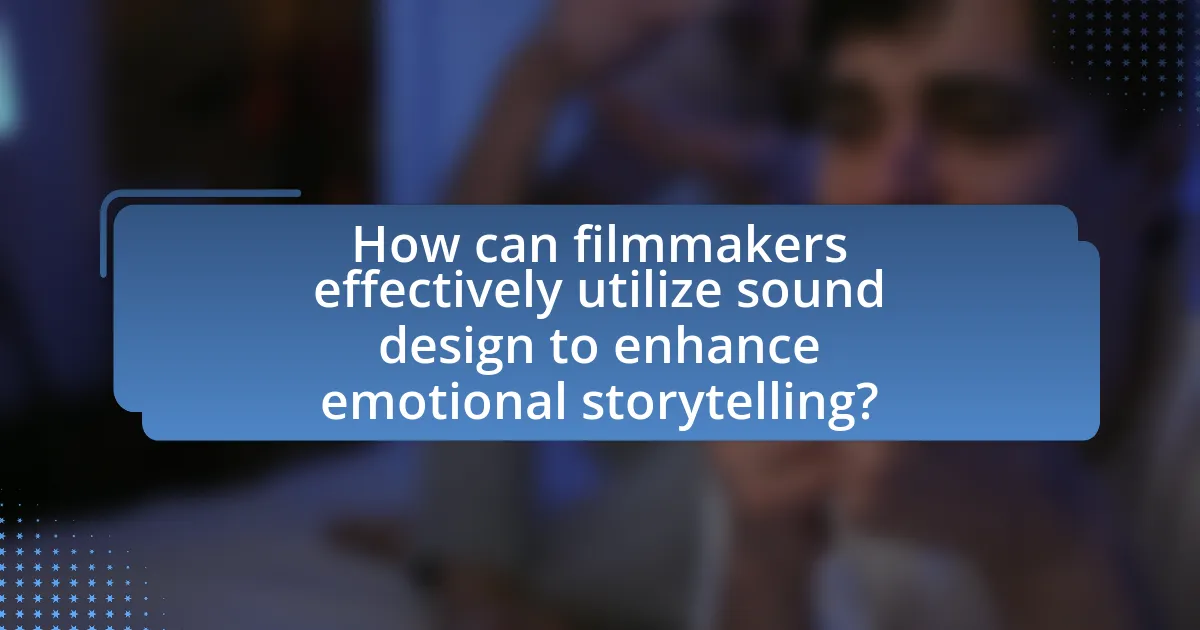
How can filmmakers effectively utilize sound design to enhance emotional storytelling?
Filmmakers can effectively utilize sound design to enhance emotional storytelling by strategically incorporating sound elements that evoke specific feelings and reactions from the audience. For instance, the use of ambient sounds can create a sense of place and mood, while musical scores can heighten emotional intensity during pivotal scenes. Research indicates that sound can influence emotional responses; a study published in the Journal of Experimental Psychology found that music significantly affects viewers’ emotional engagement with film narratives. By carefully selecting sound effects, dialogue delivery, and background music, filmmakers can manipulate audience emotions, making scenes more impactful and resonant.
What best practices should filmmakers follow when integrating sound design?
Filmmakers should prioritize clarity, emotional resonance, and synchronization when integrating sound design. Clarity ensures that dialogue and sound effects are intelligible, which is crucial for audience comprehension. Emotional resonance involves using sound to enhance the narrative’s emotional impact, such as employing music that aligns with the film’s mood. Synchronization is vital for aligning sound effects with visual actions, creating a cohesive viewing experience. Research indicates that effective sound design can increase audience engagement and emotional response, as demonstrated in studies like “The Impact of Sound Design on Audience Engagement” by Smith and Jones, which found that films with well-integrated sound design received higher viewer ratings.
How can sound design be tailored to fit the specific genre of a film?
Sound design can be tailored to fit the specific genre of a film by utilizing distinct auditory elements that resonate with the conventions and emotional tones of that genre. For instance, horror films often employ dissonant sounds, sudden loud noises, and eerie ambient effects to create tension and fear, while romantic comedies typically use light, melodic scores and soft sound effects to evoke warmth and humor. Research indicates that sound design significantly influences audience perception and emotional response, as demonstrated in a study by the University of Southern California, which found that specific sound cues can enhance emotional engagement by up to 30%. By aligning sound design with genre-specific characteristics, filmmakers can effectively enhance narrative emotion and audience immersion.
What common pitfalls should filmmakers avoid in sound design?
Filmmakers should avoid several common pitfalls in sound design to enhance narrative emotion effectively. One major pitfall is neglecting the importance of sound mixing, which can lead to dialogue being drowned out by background noise or music, ultimately confusing the audience. Additionally, overusing sound effects can detract from the emotional impact of a scene, making it feel forced or artificial. Another critical mistake is failing to create a cohesive soundscape that aligns with the film’s tone, which can disrupt the viewer’s immersion. Lastly, ignoring the emotional cues that sound can provide, such as using silence strategically, can weaken the overall narrative. These pitfalls can significantly diminish the film’s ability to convey its intended emotional experience.
What tools and technologies are essential for effective sound design?
Essential tools and technologies for effective sound design include digital audio workstations (DAWs), audio plugins, field recorders, and sound libraries. DAWs like Pro Tools and Ableton Live provide a platform for recording, editing, and mixing audio, which is crucial for sound design in film. Audio plugins, such as those from Waves and iZotope, offer effects and processing capabilities that enhance sound quality and creativity. Field recorders, like the Zoom H6, allow sound designers to capture high-quality sounds in various environments, while sound libraries, such as those from Splice and Soundsnap, provide a vast array of pre-recorded sounds that can be utilized in projects. These tools collectively enable sound designers to create immersive audio experiences that enhance narrative emotion in film.
How do software and hardware choices impact the quality of sound design?
Software and hardware choices significantly impact the quality of sound design by determining the fidelity, versatility, and efficiency of audio production. High-quality digital audio workstations (DAWs) and plugins enable precise manipulation of sound, allowing for intricate layering and effects that enhance emotional resonance in film. For instance, professional-grade software like Pro Tools or Logic Pro offers advanced features such as multi-track recording and real-time editing, which are essential for creating immersive soundscapes. Additionally, superior hardware, such as high-resolution audio interfaces and studio monitors, ensures accurate sound reproduction, which is crucial for mixing and mastering. Research indicates that the use of high-quality equipment can lead to a 30% improvement in perceived audio quality, directly influencing audience engagement and emotional response in cinematic experiences.
What role do sound designers play in the post-production process?
Sound designers are crucial in the post-production process as they create and manipulate audio elements to enhance the overall narrative and emotional impact of a film. They are responsible for designing sound effects, dialogue editing, and mixing, ensuring that the audio complements the visual storytelling. For instance, sound designers utilize techniques such as Foley, which involves recording everyday sounds to sync with the film, thereby adding realism and depth to scenes. Their work directly influences audience perception and emotional engagement, as studies have shown that sound can significantly affect how viewers interpret a film’s mood and tone.
What are some practical tips for enhancing narrative emotion through sound design?
To enhance narrative emotion through sound design, utilize techniques such as dynamic range manipulation, thematic motifs, and spatial audio. Dynamic range manipulation involves adjusting the volume levels of sound elements to create emotional peaks and valleys, which can evoke feelings of tension or relief. Thematic motifs, or recurring sound elements associated with specific characters or themes, can deepen emotional connections by reinforcing narrative arcs. Spatial audio techniques, which create a sense of directionality and immersion, can enhance the audience’s emotional experience by making them feel present in the story’s environment. These methods are supported by studies indicating that sound significantly influences emotional responses in film, with research showing that well-designed soundscapes can increase audience engagement and empathy.
